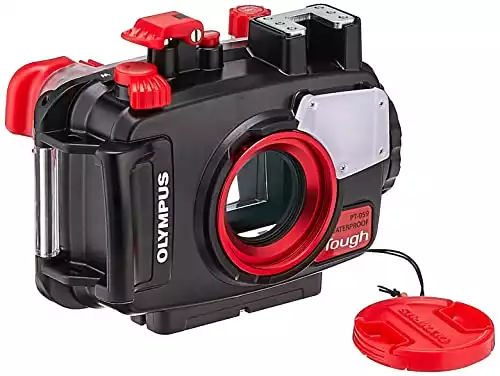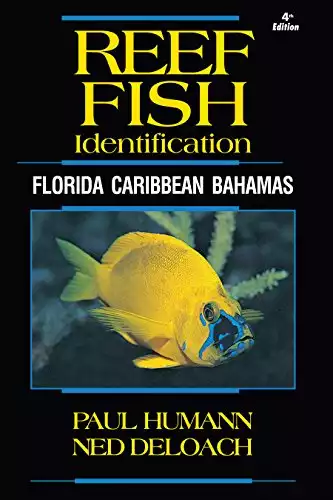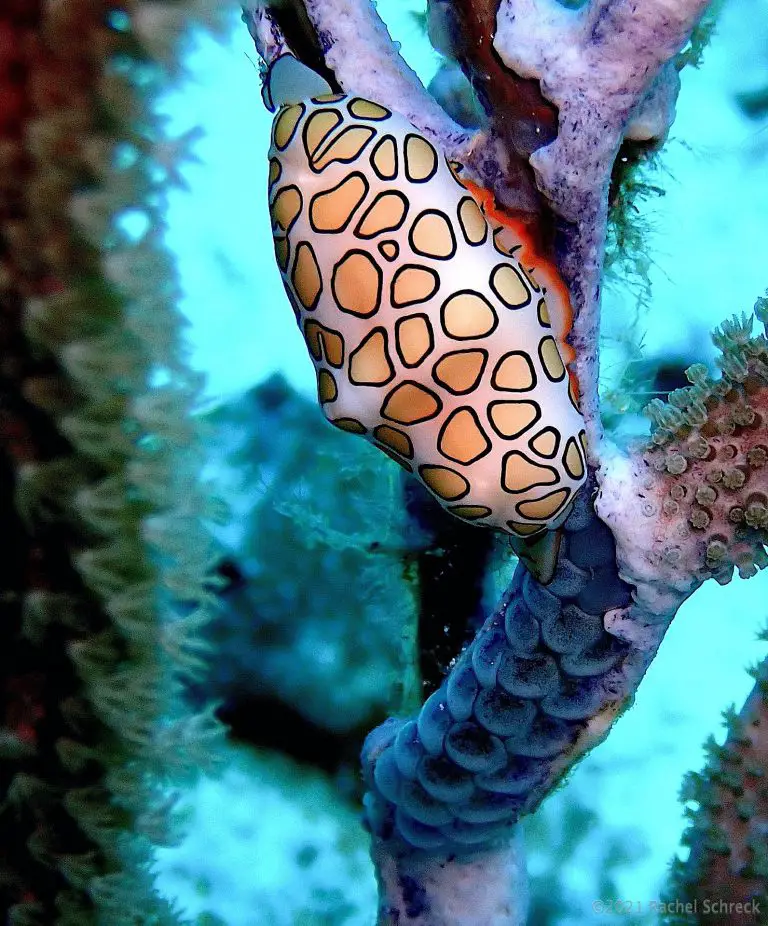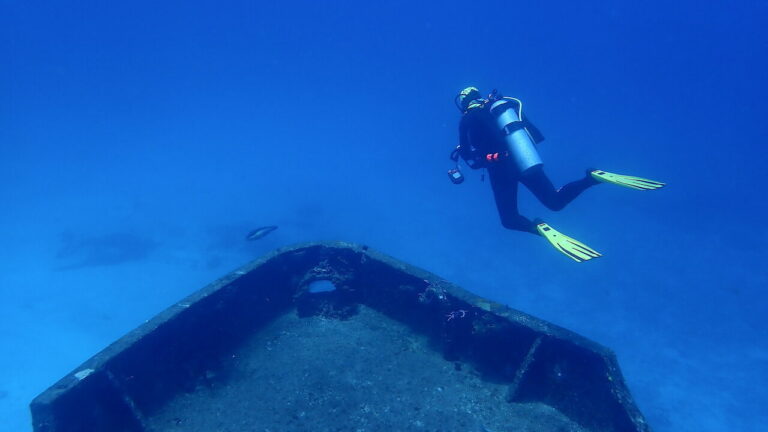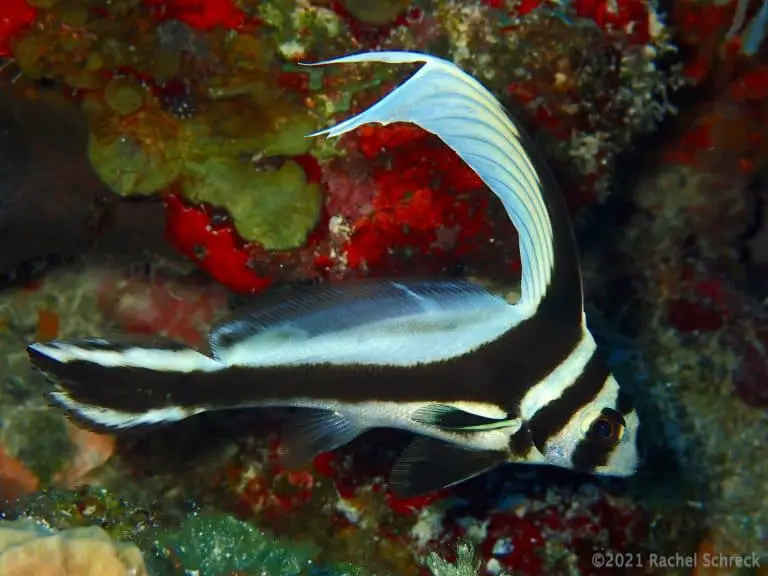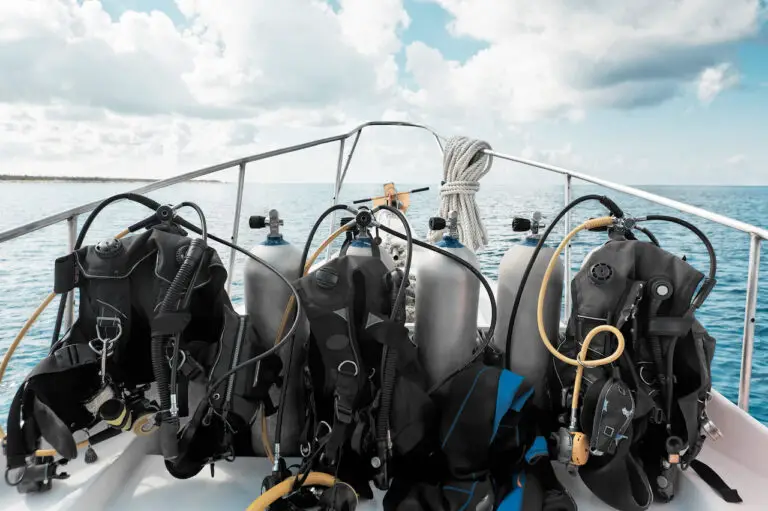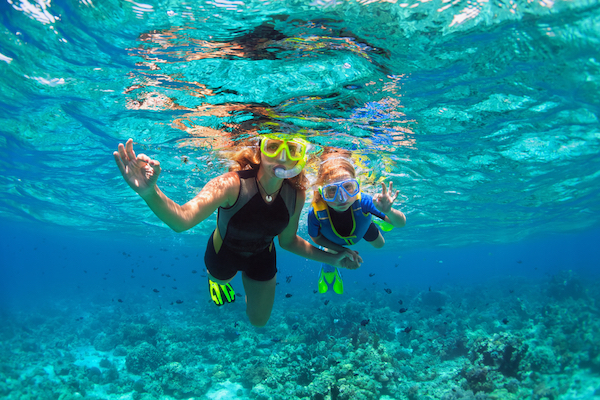Cozumel Marine Life – Diving with (Big) Moray Eels
Eels are an exciting and commonly seen marine life species on any dive here in Cozumel. Marine eels also make for great underwater macro subjects if found in an accessible spot.
Scuba divers in Cozumel frequently encounter various marine eels. The most common types of eels in Cozumel are in the moray eel classification, namely green morays, spotted morays, purplemouth, and goldentail. Other typical eels to see here are sharptail eels and garden eels.
Most of the eels you might see while scuba diving in Cozumel tend to hide out in shady nooks and crannies along the reefs, so you have to know where to look and keep your eyes peeled.
But once you spot one, it normally will hang out, keeping its face and neck exposed. Marine eels in the Caribbean don’t spook too easily, so you can take your time and frame up a nice underwater photo or two.
It’s sometimes tricky to know where to look for the various types of eels when scuba diving in Cozumel, though, so read along here for some sense of their likely hiding spots.
Goldentail Moray Eel
Maybe the most common type of marine eel I’ve seen while diving in Cozumel over the years is the small-to-medium-sized goldentail eel (Gymnothorax miliaris).
Goldentail moray eels are usually about 20-60cm long, and about 5-7cm in width.
These eels are on the small side, typically, and don’t exactly jump out at you.
They may be the most common, but they’re also often the most naturally camouflaged.
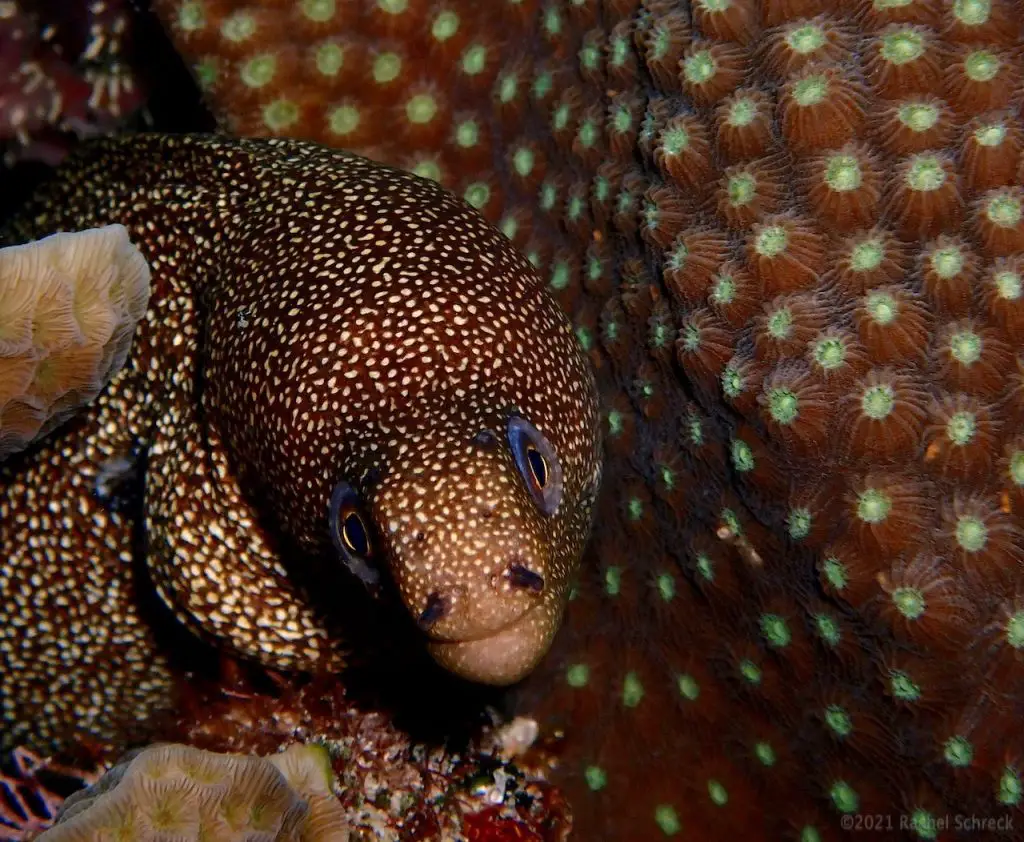
Goldentail morays will come out on the prowl for food during the day, sometimes, and when they do they’re often joined by foraging fish, like a small grouper-type.
Most goldentail moray eels that I’ve seen here have this darker look, with brownish background and yellow spots, but some – that now seem very special to me – are more predominantly yellow with smaller brown-black spots and patterning.
Like this cute moray eel:
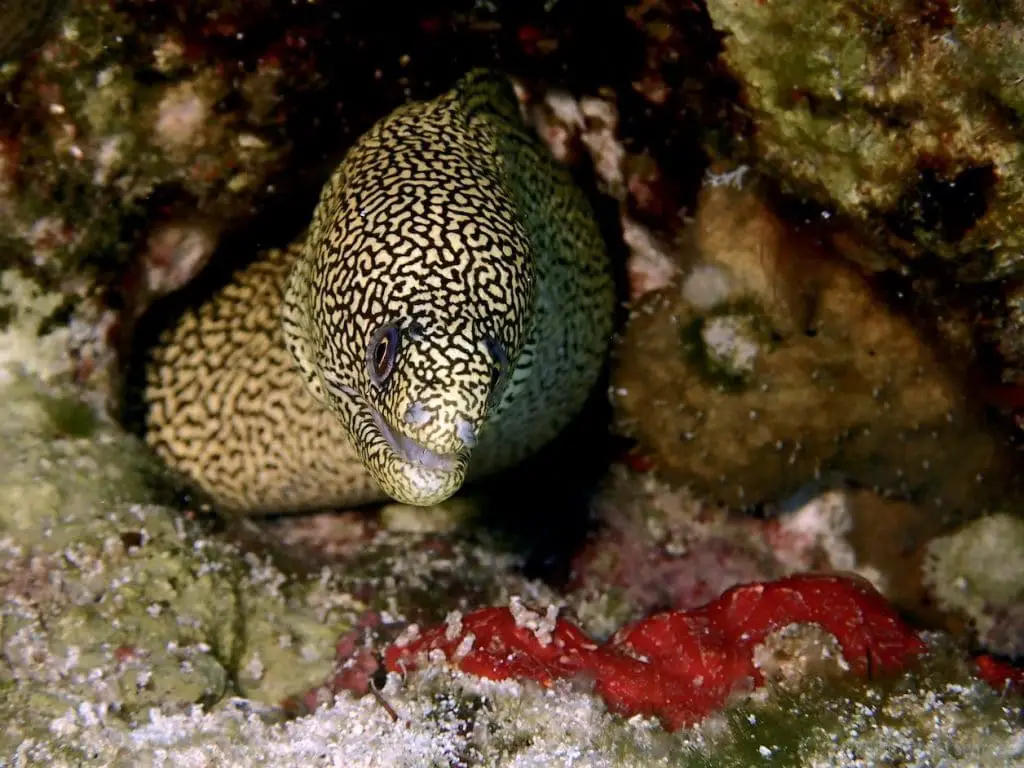
Sometimes a good way to find a goldentail moray eel in Cozumel is to also look out for small grouper-type fish that are swimming around in a certain spot, or seem to be making a search pattern.
Frequently, the groupers and the morays work in pairs to forage and hunt.
Sometimes the eel is still partially hidden and the grouper fish hover out front, as shown below.

Other times, you might see the smaller eels swimming out around a coral head with their grouper partner at their sides, or very close by.
Green Moray Eel – Common in Cozumel
Much larger – and much more visible due to its vibrant green color – is the aptly named green moray eels (Gymnothorax funebris).
Specimens like this huge eel, below, are not every-dive encounters, but there are many of these green morays inhabiting the reefs of Cozumel.
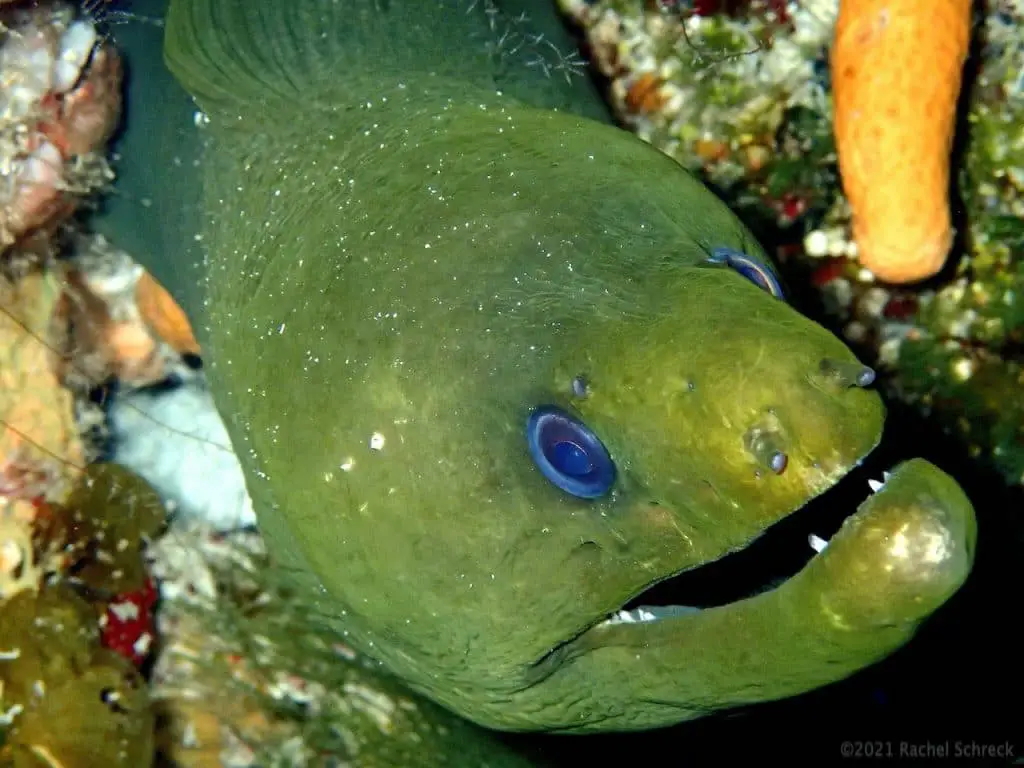
The green moray eels in Cozumel are typically quite large, getting as big as 5’/1.7m in length, with a good and chunky girth.
Green moray eels are far more likely to forage for food at night, so keep an eye out for their graceful motions on a night dive. We sometimes do get lucky and see them out during the day, which makes for a visual treat, too, given their emerald green tones swimming like a huge ribbon in the sunlight.
Cozumel’s best shipwreck dive, the C-53, is also a good spot to spot some big eels. They frequently find nice cubby holes in various parts of the ships to chill out for a while.
But, alas, normally when you see them in the daytime, they’re tucked under large coral heads or rocky outcroppings.
Spotted Moray Eels are Plentiful in Cozumel
My favorite eels in Cozumel have to be the spotted moray (Gymnothorax moringa).
Spotted moray eels are often very well hidden, at least during the day.
They tend to have longer, more pointed snouts and jaws full of white, sharp-looking little teeth.
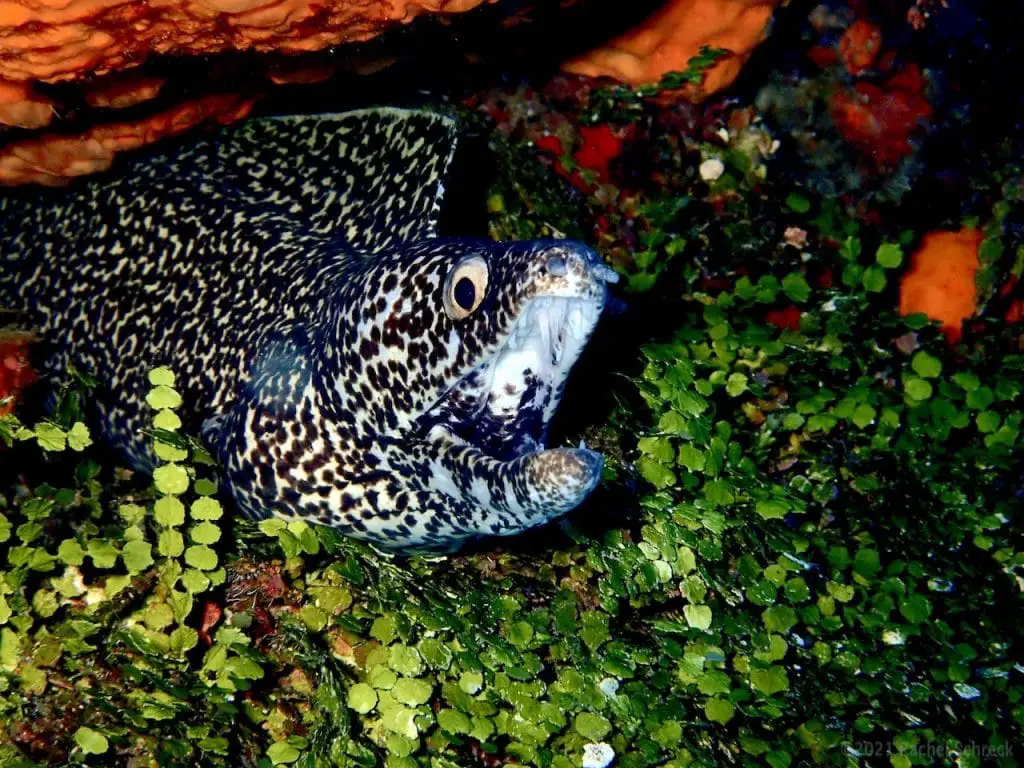
Very often, you’re just as likely to see a small bit of one’s tail peeking out of a coral crack than you are its face.
Spotted moray eels are usually sized in between the large green morays and the smaller goldentail eels. In other words, it’s not a huge eel, but they are substantial.
Most spotted moray eels that I’ve seen here are in the 2-3foot/1m range, and about 3-4”/10cm wide.
Sharptail Eel is a Cozumel Treat
Sharptail eels are very cool looking, and a little unusual in that they can often be spotted out in the open for long stretches of time, and don’t seem to be that bothered by divers.
They’re not super common, but when spotted, they’re often in grassy areas and can blend in a little bit, despite their unique coloring.
The sharptail eel’s bright yellow spots, much blunter snout, and long, exposed and narrow bodies make them look a fair bit different than their moray cousins.
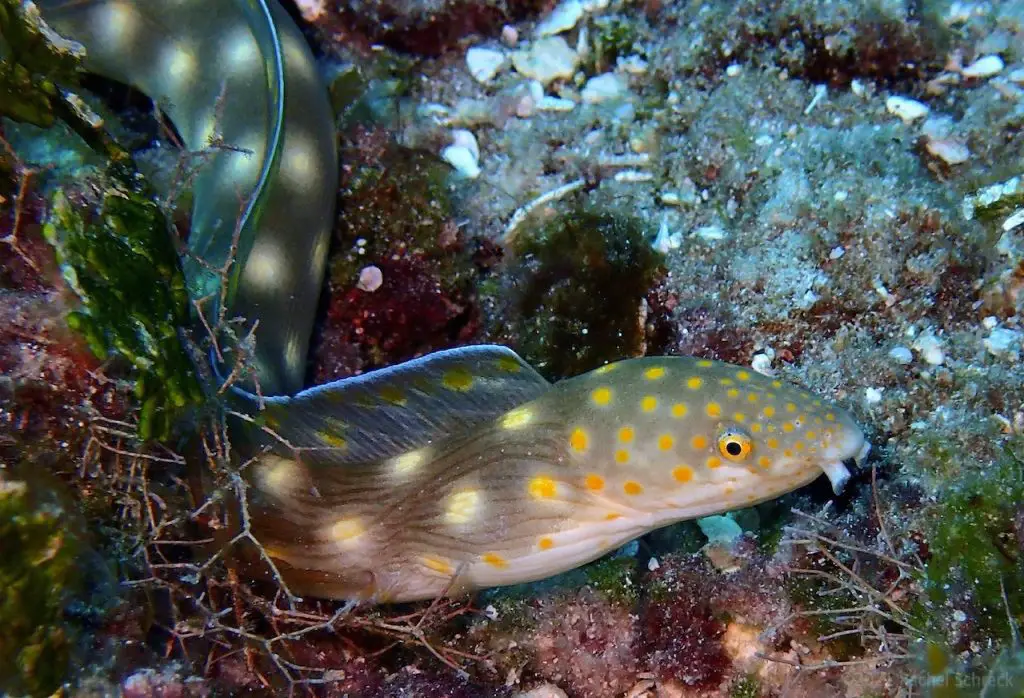
In fact, they can look like a sea snake at first, until you get a good look at their rather cute, muppet-like face.
Purplemouth Moray Eel
The purplemouth moray eel is another uncommon type of eel here, but I have seen it on a handful of occasions here in Cozumel.
Purplemouth morays often hide out in dens UNDER the sand, typically in a rocky hole below the surface in a wide sandy area. I’ve seen them the most in the sandy flats at the end of Palancar dives, like Caves or Gardens.
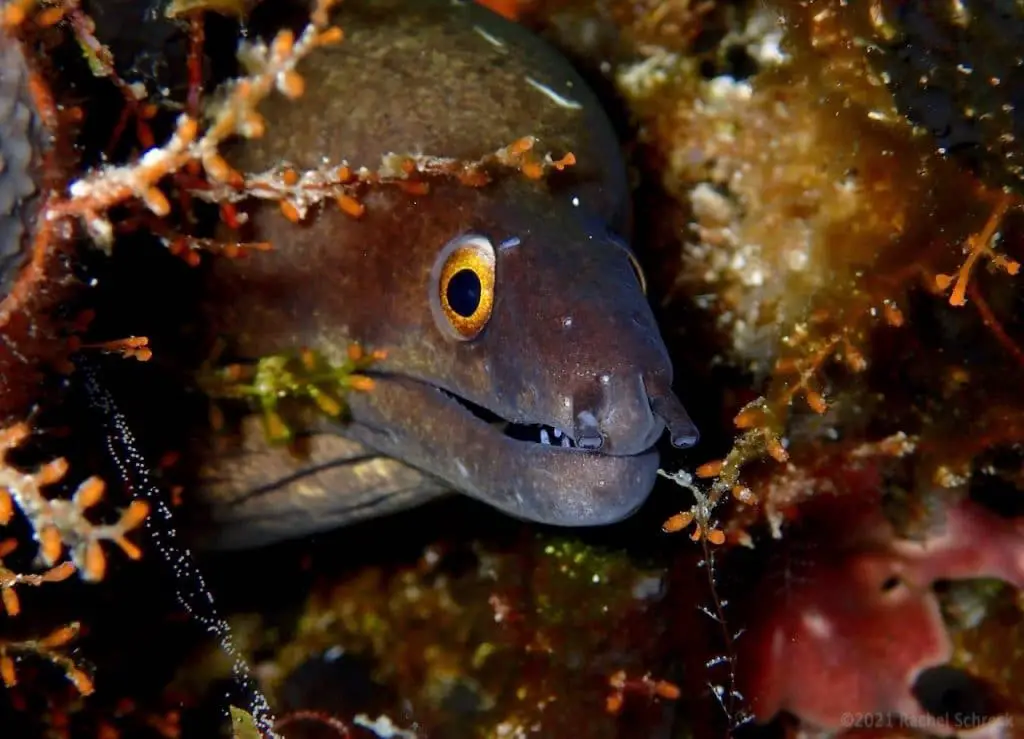
To me, the best distinguishing features of the purplemouth moray eel are its eyes. They are a deep amber yellow color, making this eel stand out from another local (but more rare) eel, the viper moray.
Garden eels
As someone who likes to take a lot of underwater macro photos in Cozumel, these garden eels are a neat marine life encounter, but a frustrating photo subject.
If you’re familiar with garden eels, you’ll know that they cluster in rows in a certain patch of sand on the ocean floor – looking like a small garden planted with diminutive eels. (hence the name…)
The closer you get to them, the more they’ll gradually retract and recede into their sandy hiding holes.
Often, divers will come across large groups of garden eels in the sandy areas of deeper dive sites, like Palancar Bricks or Santa Rosa, between the wall and the shallows.
Unless you’re already gliding over the sand looking for Caribbean conchs, baby flounders, or pikeblennies, though, it’s not worth the air to go back down deep for a picture of these guys – they’ll just nonchalantly disappear on you.
Leaving you with something lackluster, like this:
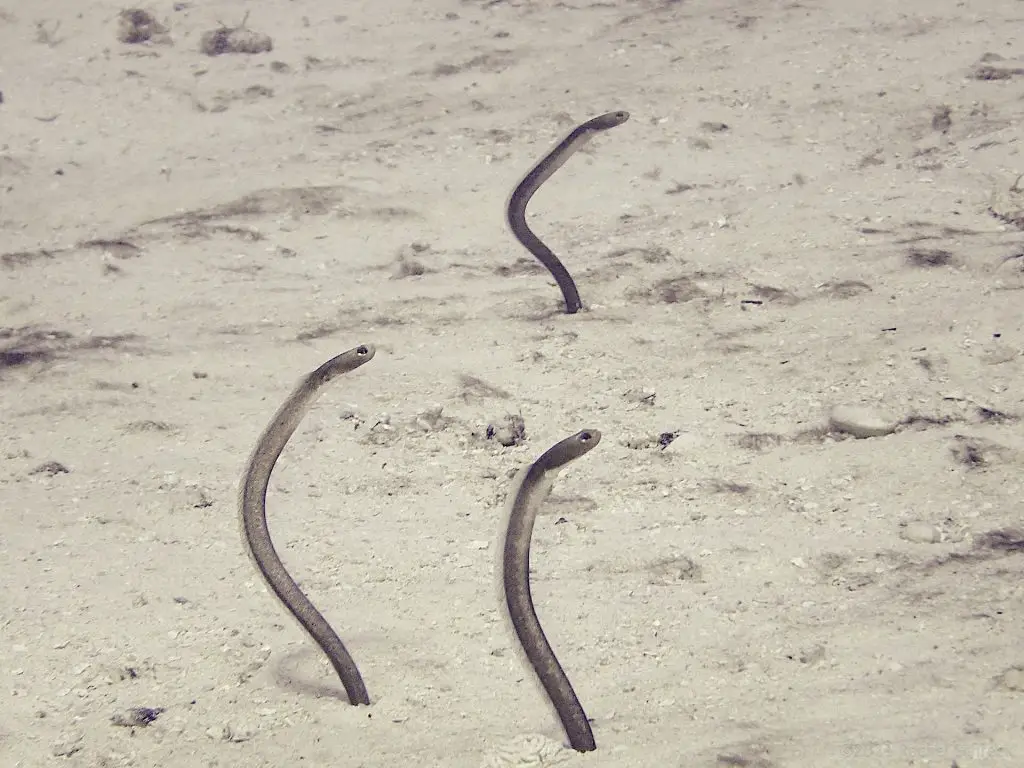
The best view of them is from above, where you can take in and appreciate the whole bunch of them, their pack behavior, and watch their synchronized movements with some perspective.
More Mysterious Eels in Cozumel
This is an odd one I’ve only seen once (that I know of…) and it also didn’t really cooperate for a picture.
At first, all I saw was something tunneling under the sand in a shallow area of a dive.
For a while.
My friend the divemaster spotted it, too, and encouraged me to wait – clearly he knew what it was.
Just when I almost gave up, this little snout emerged from the sand, just barely making itself visible.
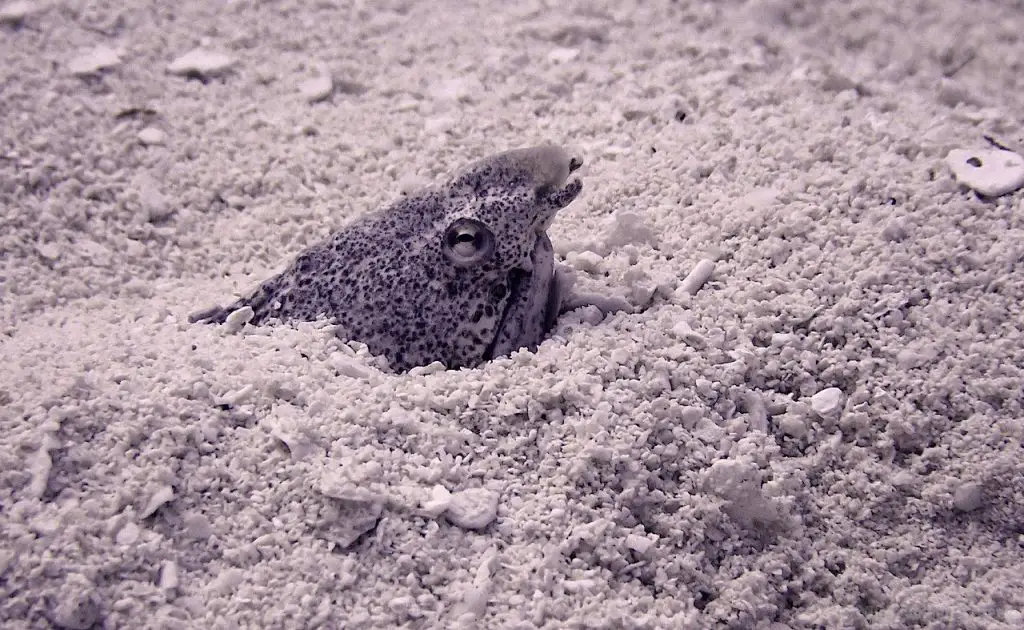
To the best of my knowledge, and more armchair marine bio work using my favorite reef ID books (see the end of this post for my favorite critter reference books to add to your dive library), it’s maybe the spotted snake eel, or maybe the shorttail snake eel?
As always, if any of you know for sure, please contact me through this website’s contact page and let me know.
It IS Safe to Photograph Moray Eels in Cozumel
Just don’t get too close, or make any false moves!
Moray eels are not aggressive toward humans in the wild and are not known to charge or even approach scuba divers.
If you approach calmly, most eels will stay in place, and keep their head and face visible, offering a good opportunity for an underwater photograph.
Very often, pictures of eels show them with their jaws open and exposing their many needle-like teeth, so they appear to be in a somewhat fierce and menacing pose.
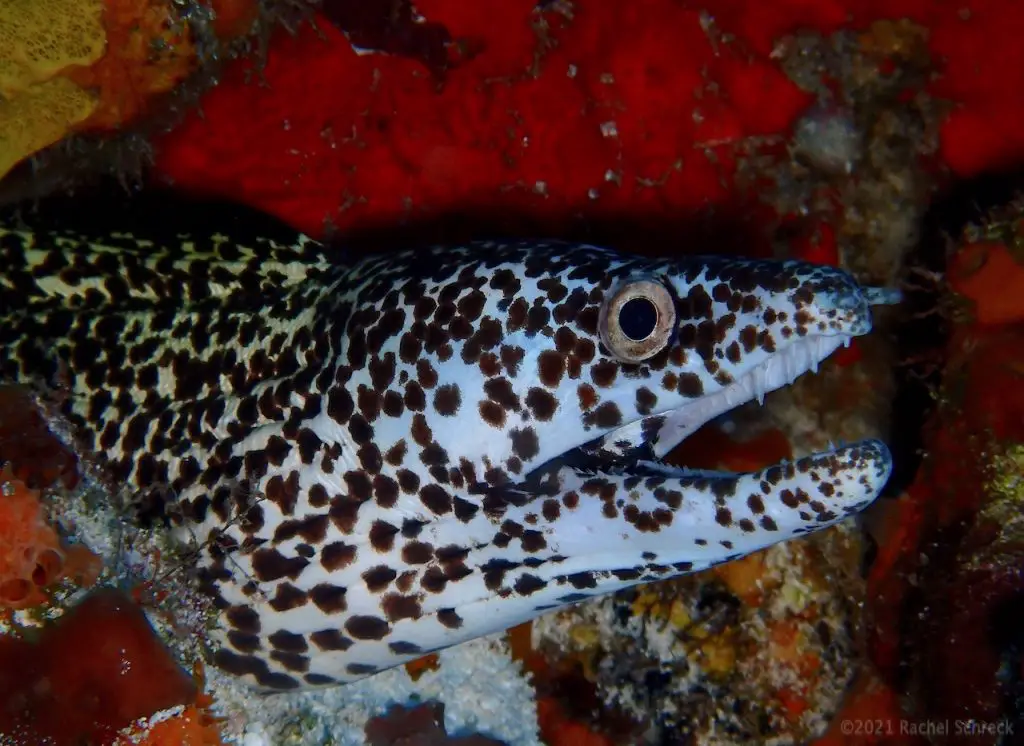
According to this article from the U.S. National Aquarium, this is not an indication of aggression at all, but typically just a function of the eel’s respiratory system.
Moray eels compensate for a lack of bone structure in that area by opening and closing their mouths a lot in order to ‘pump’ water around and through their gills to ‘breath’.
As a general rule, it is very safe to dive near moray eels in the ocean, and if you approach with care and respect their space, eels will remain visible and allow a good and safe look at their face and teeth. Scuba divers should not feed, startle, or even touch moray eels, as these behaviors are the most common causes of moray eel bites.
Most moray eels feed at night (mainly on crabs, shrimp, and octopus), so some additional precautions should be taken during night dives to make sure you don’t contact or frighten them.
Moray eels have lots of sharp teeth, and two sets of jaws – including the secondary pharyngeal jaws, that are deeper into the eel’s throat, and also lined with more sharp teeth.
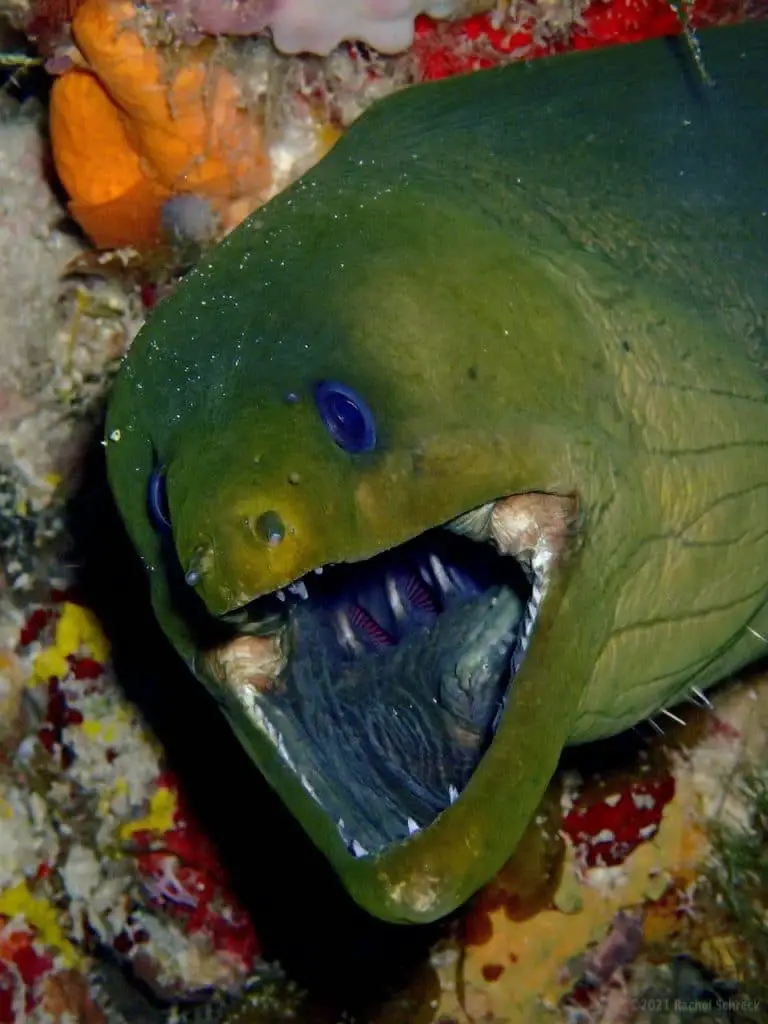
Eels also have poor eyesight and rely on their sense of smell to hunt. As you can imagine, a sudden movement or any other move you make that could give the eel a sense of threat or danger could have disastrous results, even causing them to react and lash out with a bite.
Though rare, and often affecting aquarists more than scuba divers, bites from moray eels are known to be very painful, and likely to cause a lot of blood loss, given the eels’ many sharp and angled teeth.
Marine eel bites are not typically life-threatening, and eels are not poisonous or venomous.
However, moray eels also often have various toxins in their skin and mouth that can adversely affect the victim of a bite wound, and perhaps cause the wound to become infected.
What to Do in Case of a Moray Eel Bite
If you were to get an eel bite while diving or snorkeling, safely terminate your dive or activity as quickly as possible. Then, according to healthline.com, it is important to:
- flush and wash the wound
- apply pressure to stop the bleeding
- seek medical attention, asap
Ideally, you would eventually dress the wound with an antibacterial treatment to prevent infection from the eel’s natural toxins. It is also likely that pain medication will be advised.
As mentioned, once able, you should also proceed to the nearest Cozumel hospital or clinic to get the eel bite checked for infection, see if you need stitches or a tetanus shot. Some dive safety resources also remind you to also stay aware of how you feel and take note of any unusual symptoms that may arise, especially those that may indicate an allergic or adverse reaction to the eels’ natural toxins.
**Always be sure to get in touch with DAN to review their recommendations, or contact your alternative diver’s insurance carrier, if relevant.
Once again, being bitten by a moray eel while diving is not something you need to worry about in general, and it would be a very rare circumstance, indeed.
But as certified divers, it’s always good to think through potential accidents and how you should respond, including having information on Cozumel’s best and brightest hospitals that understand diving injuries bookmarked in your phone.
Cozumel’s Eels for Reliable UW Macro Photography:
The local marine eel population is more proof that Cozumel is really good for

Eels are some of the best subjects on the reefs, especially if you’re an
That’s because they’re plentiful, and usually seem very comfortable to stay out and remain visible. They almost seem to pose, without actually moving forward or coming closer to you or your underwater camera.
The only better subjects might be our numerous resident sea turtles.
There have been some anecdotes of Cozumel’s better-known large resident green moray eels getting more curious and forward towards divers lately, or at least more prone to leaving their dens and coming closer to divers.
Stories like this seem to indicate that some divers and dive guides may have brought food along to entice the eels out for a better look, causing the eels to associate divers with a free snack.
This would obviously go against Cozumel’s protected national marine park rules, general ethical diving rules (as in: “leave only bubbles, take only photos”) and is potentially a dangerous idea.
Eels are good hunters and can fend for themselves just fine. You getting a good snapshot is not worth messing with marine life.
- Easy to use
- Easy to pack
- Easy on the wallet
- Durable, waterproof, dustproof
Learn more about Cozumel's fish - including sharks, rays, and eels


